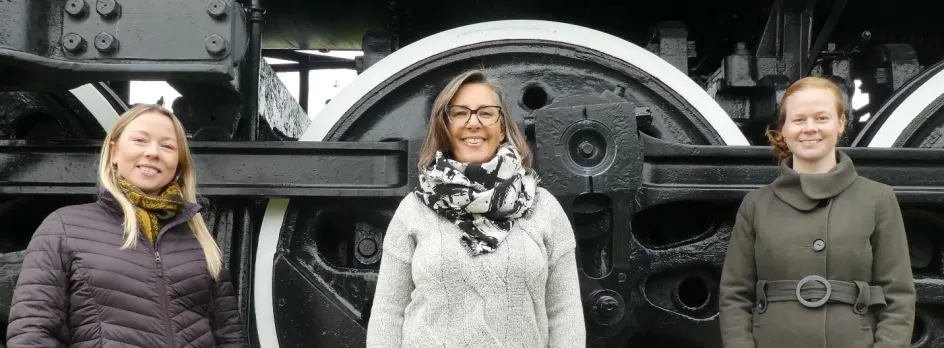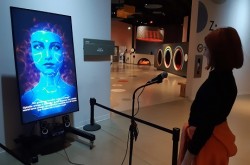Behind the scenes: Meet Ingenium’s travelling exhibitions team

Exhibitions are the backbone of most museums, but what you may not know is they don’t always stay put within the museum walls. Travelling exhibitions enable museums to share colourful stories and engaging educational content with audiences around the world — instead of being limited to local audiences.
At Ingenium – Canada’s Museums of Science and Innovation, the travelling exhibitions team — Maren Hackett, Alison Ward, and Julie Leclair — work hard to make a range of exhibitions accessible to communities across Canada and beyond. The Ingenium Channel sat down with the team to find out more about what their work entails — and a new carbon-neutral shipping initiative.
Ingenium Channel (IC): How is a travelling exhibition different than a permanent or temporary exhibition?
Maren Hackett: A permanent exhibition is one that is on long-term display in a main gallery of the museum, and usually features items from the museum’s own collection. A temporary exhibition might be a special, short-term showing of artifacts from a museum’s own collection, or it could be a borrowed exhibition. A travelling exhibition is one that is produced by a museum, science centre, art gallery, or exhibition production company and is shown at more than one venue. Travelling exhibitions are accessible to a greater number of visitors in different regions, and they can attract new audiences by adding interest to host museums whose exhibitions might change infrequently.

Cipher | Decipher is a travelling exhibition that explores the past and present of communications cryptology.
IC: Tell me more about the behind-the-scenes work performed by Ingenium’s travelling exhibition team.
Julie Leclair: The travelling exhibition team starts working on an exhibition right at the very beginning of its inception. We start with market testing, to see how potential venues react to the subject matter. Then we work with the exhibition development team to ensure that the exhibition will be easy to install (and dismantle), and engaging for visitors.
Once an exhibition is built and ready to ship, we work with host venues to sign contracts, coordinate shipping, troubleshoot any installation (or dismantling) issues, help with marketing and promotion, and provide support for the full duration of the booking. Then we do it all over again for the next venue! We also collaborate with our colleagues around the world to share our best practices and learn from others.

Getting ready to roll: A view of the Cipher | Decipher travelling exhibition being packed for its next destination.
IC: Where do Ingenium’s exhibitions go? Who rents them?
Alison Ward: Ingenium’s exhibitions go practically everywhere in Canada. They’ve travelled from Mount Pearl, Newfoundland to Iqaluit, Nunavut to Port Alberni, British Columbia. Typically, they would be rented by small to mid-sized museums, but our exhibition hosts also include libraries, universities, large museums, and sometimes even conferences, festivals, corporations, and embassies.
Several exhibitions, such as Game Changers, have been popular with American museums. Two of our exhibits, On the Trail of the Monarch Butterfly and Climate Change is Here, have also travelled to Mexico.
I think some potential hosts may assume that our exhibitions are prohibitively large because we’re a national institution, but the reality is the complete opposite; our exhibitions are designed to go anywhere and be hosted by any sort of institution.

A view of Eyes on the Skies, a travelling exhibition that examines the evolution of air traffic management and the systems, people, and technologies that keep our busy skies safe.
IC: How often do they move? How long do they typically stay on tour?
Maren Hackett: A rental is usually about 12 weeks, so an exhibition typically moves about three times a year. A tour might last only a year; for instance, the Canada Agriculture and Food Museum developed a travelling exhibition to tour during the International Year of Pulses in 2016. Some tours could last 10 years or more if the topic is timeless, but usually a combination of wear and tear — and the need to update content — limit a tour to between five and 10 years.

The Eyes on the Skies travelling exhibition is packed and loaded into a truck for shipping.
IC: I understand that Ingenium’s travelling exhibitions now offer carbon neutral shipping. How does that work, and why is it important?
Julie Leclair: We are so excited to announce that we are carbon neutral for the shipping of all of our travelling exhibitions. For the past year, the team has been thinking about how we can be a greener program. Knowing that shipping causes just over three percent of the world’s carbon emissions, we thought perhaps offsetting our carbon footprint for our shipping might be a good place to start.
Offsets are designed to help mitigate the emissions associated from one activity with another activity that avoids or reduces the equivalent amount of emissions. For example, emissions caused by shipping 13 exhibitions around North America can be neutralized by preventing the release of an equivalent amount of emissions through the implementation of a renewable energy project.
We worked with the Canadian carbon offset company, Less Emissions, to determine our carbon emissions. And we are pleased to announce that Ingenium has acquired and retired just over 36 tonnes of carbon dioxide equivalent (CO2e) to offset emissions caused by the shipping of our travelling exhibitions across North America. We know this is just the start on our greening journey, but we are proud to be one of the first in the travelling exhibition industry to be carbon neutral for all of our shipping. We hope to encourage other travelling exhibition producers to do the same.
IC: Are there other sustainability initiatives that you hope to introduce in the future?
Alison Ward: Absolutely. The most obvious next step is to continue to offset other elements of our travelling exhibitions work. For example, if one of us travels to meet up with an exhibition on the road or to attend a conference, we could offset that travel. The greater step, however, will be moving away from offsetting the exhibitions’ footprints to reducing the footprints in the first place. It’s the same as needing to move away from recycling to reducing.
The travelling exhibition industry needs to move toward producing exhibitions with low-emission materials and in a low-emission fashion. This will be a challenge, but not impossible by any means. For example, exhibition panels can be made from inedible biodegradable sorghum stock, instead of plastic or metal. Recycled aluminum can be used for case frames, and reclaimed wood is now an option for shipping crates. Today, there are a multitude of new products made from recycled plastic; there are many options to explore. As sustainability is increasingly included in decision-making across every industry and sector, it will become more natural for all of us to choose sustainable options.
Another way Ingenium can reduce the environmental impact of its travelling exhibitions is to pursue digital options. We already have two “download-and-display” exhibitions where host venues can display exhibition panels digitally. As a result, there are no emissions generated from fabrication or shipping. With ever-increasing online connectivity, we feel there is plenty of room for expansion within the realm of digital exhibitions!
So, all of this to say, going carbon neutral for the shipping of our travelling exhibitions is only the beginning.
By the numbers: Ingenium’s travelling exhibitions
5,996,264: Number of visitors who experienced Ingenium’s travelling exhibitions in the past five years
46,823: Number of kilometres travelled by the Ace Academy exhibition (and it’s still travelling!)
5,758: Number of kilometres travelled by the Health in Space exhibition in its longest single trip between venues, between Fort Smith, NT to Saint John, NB
40: Total shipments of Ingenium’s travelling exhibitions in 2019
1.69: Number of trips around the world taken by Ingenium’s travelling exhibitions in 2019
36.230: The number of tonnes of CO2 that Ingenium has acquired and retired, to offset emissions caused by shipping their travelling exhibitions across North America
Enjoying the Ingenium Channel? Help us improve your experience with a short survey!
































































